|
1932 Democratic National Convention
The 1932 Democratic National Convention was held in Chicago, Illinois June 27 – July 2, 1932. The convention resulted in the nomination of Governor Franklin D. Roosevelt of New York for president and Speaker of the House John N. Garner from Texas for vice president. Beulah Rebecca Hooks Hannah Tingley was a member of the Democratic National Committee and Chair of the Democratic Party of Florida. She seconded the nomination of Franklin Delano Roosevelt, becoming the second woman to address a Democratic National Convention. According to the White House Historical Association, Happy Days Are Here Again was the campaign song of the convention.[1] The candidatesThe three major candidates:
Convention The three major contenders for the presidential nomination were Roosevelt, Garner and former Governor of New York and 1928 presidential candidate, Al Smith, who roughly represented three competing factions of the Democratic Party:
The new Democratic coalition would begin at this convention: Roosevelt brought into the Democratic fold western progressives, ethnic minorities, rural farmers, and intellectuals. Supporters of Roosevelt pushed for the abolition of the two-thirds rule (which required the presidential nominee to win at least two-thirds of the delegate votes), but backlash from Southern delegates forced them to drop the proposal.[3] After three ballots, Roosevelt was 86.75 votes short of the 769.5 votes required to win the nomination, and his campaign feared that his support had peaked: as none of New York, New Jersey, Massachusetts or Connecticut supported Roosevelt, he needed McAdoo, who led the California delegation, and Garner, who led the Texas delegation. Roosevelt's campaign was able to persuade Garner to have his delegates vote for Roosevelt, possibly with the help of Hearst: while Hearst disliked Roosevelt, he hated Smith and Newton D. Baker, a possible compromise candidate. After McAdoo (who had been denied the nomination by the two-thirds rule at the 1924 convention) announced that California would back Roosevelt, the convention realized Roosevelt had reached the required 769.5 delegates to win the nomination, which was greeted by wild celebrations. Roosevelt received 945 votes on the fourth ballot to Smith's 190.5.[3] Garner was nominated for vice-president by acclamation, likely as part of a deal for his delegates.[4] McAdoo had hoped to be on the ticket, but he withdrew after his inclusion was opposed by Hearst.[5]
Presidential Balloting / 5th Day of Convention (July 1, 1932)
Roosevelt's acceptance speechFor his acceptance speech, Roosevelt broke tradition and established the precedent of formally accepting the nomination in person at the convention. In his speech, he pledged "a New Deal for the American people".[4] See also
References
Pietrusza, David 1932: The Rise of Hitler & FDR: Two Tales of Politics, Betrayal, and Unlikely Destiny Guilford CT: Lyons Press, 2015. External links
|
||||||||||||||||||||||||||||||||||||||||||||||||||||||||||||||||||||||||||||||||||||||||||||||||||||||||||||||||||||||||||










